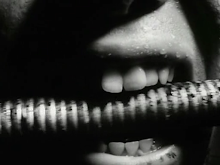
Who is Conrad Rooks? His only other film credit, besides "Chappaqua," is an early 70's adapatation of "Siddhartha," which was probably more revered for its cinematography by Ingmar Bergman collaborator Sven Nykvist than anything else. The question is asked in "Chappaqua," Rooks' autobiographical depiction of the wonderland of narcotics, which attempts to assess the identity of a man who has relied on consciousness-altering substances since his early teens, as well as the identity of a culture which surrounded his addiction. An informative card in the opening credits tells the audience all of the background information, and it is assumed that Rooks is just a former addict with a story to tell.
As "Chappaqua" gets going, one sees that it is not really a story at all, but a pastiche of beautiful and haunting images, themes, and visual ideas. Conrad Rooks apparently stars as himself, veiled as a character named Russell Harwick, and his tale begins in New York city - where debauchery has made a monster out of him. He lies on the floor of a nightclub munching crushed fragments of LSD and avoiding people's dancing feet. Infused around this sequence are various vibrant shots of urban glitter, ferociously edited together using blended opacities and Godardian fast cuts. The film follows Harwick into a rehabilitation clinic, where he is promised a "sleeping cure" for his drug addictions. What follows is a series of unconnected sequences, featuring visions of Native-American, Indian and American cultures.
The clinic immediately seems fashioned after the one in William S. Burroughs' "Junkie," and when Burroghs himself appears as Harwick's doctor it feels all the more appropriate. There is another appearance by Allen Ginsberg, and, considering the bodies of work of the two authors, the story is actually enrichened by their presences throughout the movie. "Chappaqua" is deeply inspired by the stylish, deeply personal works of the beatnik era, and its surreal, Dadaist realism takes on an interesting life of its own, especially considering the surrounding hippie movement of the time.
The film's many elusive, hallucinatory sequences are undoubtedly disjointed, but they quickly perculate into a trippy meditation on drugs and their corresponding cultures. Some of these scenes show drugs as cerominal or transcendental agents, having a spiritual purity in certain rituals. Others are nightmarish, like the unforgettable ode to American horror movies, where Harwick walks around the streets of New York City in a Nosferatu-like cloak. The film's title comes from Rooks' hometown, which is an American-Indian word meaning sacred burial ground. One of the film's prominent themes is purity in itself, whether as being devoid of controlling substances like drugs or of widespread cultural confusion. Rooks seeing 1965 New York City as a place of excess was a rare perspective for its time, but it now feels all the more astute. He explores the cultural roots of drug use to comment on the cultures in themselves, and one of the most important messages of the film is found in its pursuit for clarity of self. Irony is shown in how Native Americans and Indians once used drugs like peyote and marijuana as a means of spiritual identification, contrasted with its use as an instrument of excess in 1960's America.
Rooks seemed to channel the French New Wave in his visual and editing aesthetics, and it's not hard to connect directors like Godard and Truffaut with the visual motifs presented in the film. Rooks uses the liberating new teqhniques of the Nouvelle Vague to convey an unhinged vision of altered consciousness, and in certain ways pushes them forward. The beautiful cinematography by Robert Franks alternates between crisp B&W, washed-out B&W and grainy color in a style that may have never been used before in a feature film, and certainly wasn't used much until Oliver Stone's "JFK". Rooks' experimentation also owes some of its inspiration to a fellow American, Dr. Kenneth Anger. The cross-dissolves and occult-like imagery seem to come straight from "Inauguration of the Pleasure Dome," and the teenage motorcycle iconography of Harwick seems to be taken directly from "Scorpio Rising."
While making these connections, it is important not to thoughtlessly rank Rooks with his contemporaries. This being his first film, it is far from a realized vision. Its sequences, while impressive, are sloppily connected with way too wide of an array of themes. The frequent experimentation undermines the film's thematic strength, and the sequences only seem to add up to hopeless ambiguity by the conclusion. The locations of France, India and the the U.K. (even Stonehenge where a wizard in a white cloak waves a wand on top of the world wonder) are impressive for an independently-financed film in any era, but seem like pointless frivolousness in relation to the truly important elements of the film. Nevertheless, the arresting images and counter-cultural observations should make the movie relevant in historical and social contexts and, at very least, make it a terrific watch. Where else are you going to see a dancing wizard on top of the real Stonehenge?
**Thanks Chase for bringing this home!

No comments:
Post a Comment